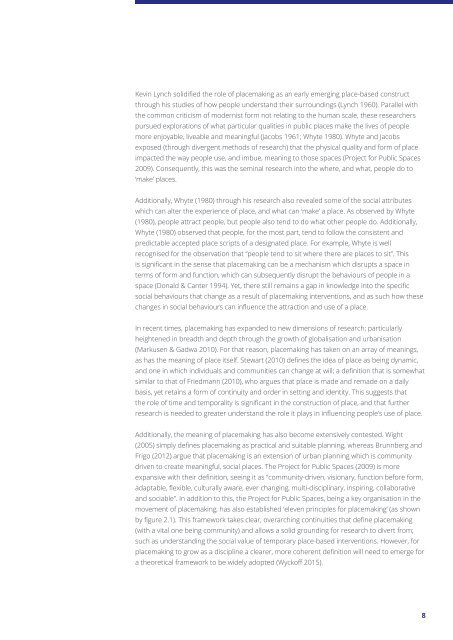Exploring the Role of 'Visual Catalysts' on Influencing People's Attraction and Use of Place
Undergraduate Thesis // Keegan Lovell // Bachelor of Landscape Architecure // UNSW 2016
Undergraduate Thesis // Keegan Lovell // Bachelor of Landscape Architecure // UNSW 2016
Create successful ePaper yourself
Turn your PDF publications into a flip-book with our unique Google optimized e-Paper software.
Kevin Lynch solidified <str<strong>on</strong>g>the</str<strong>on</strong>g> role <str<strong>on</strong>g>of</str<strong>on</strong>g> placemaking as an early emerging place-based c<strong>on</strong>struct<br />
through his studies <str<strong>on</strong>g>of</str<strong>on</strong>g> how people underst<strong>and</strong> <str<strong>on</strong>g>the</str<strong>on</strong>g>ir surroundings (Lynch 1960). Parallel with<br />
<str<strong>on</strong>g>the</str<strong>on</strong>g> comm<strong>on</strong> criticism <str<strong>on</strong>g>of</str<strong>on</strong>g> modernist form not relating to <str<strong>on</strong>g>the</str<strong>on</strong>g> human scale, <str<strong>on</strong>g>the</str<strong>on</strong>g>se researchers<br />
pursued explorati<strong>on</strong>s <str<strong>on</strong>g>of</str<strong>on</strong>g> what particular qualities in public places make <str<strong>on</strong>g>the</str<strong>on</strong>g> lives <str<strong>on</strong>g>of</str<strong>on</strong>g> people<br />
more enjoyable, liveable <strong>and</strong> meaningful (Jacobs 1961; Whyte 1980). Whyte <strong>and</strong> Jacobs<br />
exposed (through divergent methods <str<strong>on</strong>g>of</str<strong>on</strong>g> research) that <str<strong>on</strong>g>the</str<strong>on</strong>g> physical quality <strong>and</strong> form <str<strong>on</strong>g>of</str<strong>on</strong>g> place<br />
impacted <str<strong>on</strong>g>the</str<strong>on</strong>g> way people use, <strong>and</strong> imbue, meaning to those spaces (Project for Public Spaces<br />
2009). C<strong>on</strong>sequently, this was <str<strong>on</strong>g>the</str<strong>on</strong>g> seminal research into <str<strong>on</strong>g>the</str<strong>on</strong>g> where, <strong>and</strong> what, people do to<br />
‘make’ places.<br />
Additi<strong>on</strong>ally, Whyte (1980) through his research also revealed some <str<strong>on</strong>g>of</str<strong>on</strong>g> <str<strong>on</strong>g>the</str<strong>on</strong>g> social attributes<br />
which can alter <str<strong>on</strong>g>the</str<strong>on</strong>g> experience <str<strong>on</strong>g>of</str<strong>on</strong>g> place, <strong>and</strong> what can ‘make’ a place. As observed by Whyte<br />
(1980), people attract people, but people also tend to do what o<str<strong>on</strong>g>the</str<strong>on</strong>g>r people do. Additi<strong>on</strong>ally,<br />
Whyte (1980) observed that people, for <str<strong>on</strong>g>the</str<strong>on</strong>g> most part, tend to follow <str<strong>on</strong>g>the</str<strong>on</strong>g> c<strong>on</strong>sistent <strong>and</strong><br />
predictable accepted place scripts <str<strong>on</strong>g>of</str<strong>on</strong>g> a designated place. For example, Whyte is well<br />
recognised for <str<strong>on</strong>g>the</str<strong>on</strong>g> observati<strong>on</strong> that “people tend to sit where <str<strong>on</strong>g>the</str<strong>on</strong>g>re are places to sit”. This<br />
is significant in <str<strong>on</strong>g>the</str<strong>on</strong>g> sense that placemaking can be a mechanism which disrupts a space in<br />
terms <str<strong>on</strong>g>of</str<strong>on</strong>g> form <strong>and</strong> functi<strong>on</strong>, which can subsequently disrupt <str<strong>on</strong>g>the</str<strong>on</strong>g> behaviours <str<strong>on</strong>g>of</str<strong>on</strong>g> people in a<br />
space (D<strong>on</strong>ald & Canter 1994). Yet, <str<strong>on</strong>g>the</str<strong>on</strong>g>re still remains a gap in knowledge into <str<strong>on</strong>g>the</str<strong>on</strong>g> specific<br />
social behaviours that change as a result <str<strong>on</strong>g>of</str<strong>on</strong>g> placemaking interventi<strong>on</strong>s, <strong>and</strong> as such how <str<strong>on</strong>g>the</str<strong>on</strong>g>se<br />
changes in social behaviours can influence <str<strong>on</strong>g>the</str<strong>on</strong>g> attracti<strong>on</strong> <strong>and</strong> use <str<strong>on</strong>g>of</str<strong>on</strong>g> a place.<br />
In recent times, placemaking has exp<strong>and</strong>ed to new dimensi<strong>on</strong>s <str<strong>on</strong>g>of</str<strong>on</strong>g> research; particularly<br />
heightened in breadth <strong>and</strong> depth through <str<strong>on</strong>g>the</str<strong>on</strong>g> growth <str<strong>on</strong>g>of</str<strong>on</strong>g> globalisati<strong>on</strong> <strong>and</strong> urbanisati<strong>on</strong><br />
(Markusen & Gadwa 2010). For that reas<strong>on</strong>, placemaking has taken <strong>on</strong> an array <str<strong>on</strong>g>of</str<strong>on</strong>g> meanings,<br />
as has <str<strong>on</strong>g>the</str<strong>on</strong>g> meaning <str<strong>on</strong>g>of</str<strong>on</strong>g> place itself. Stewart (2010) defines <str<strong>on</strong>g>the</str<strong>on</strong>g> idea <str<strong>on</strong>g>of</str<strong>on</strong>g> place as being dynamic,<br />
<strong>and</strong> <strong>on</strong>e in which individuals <strong>and</strong> communities can change at will; a definiti<strong>on</strong> that is somewhat<br />
similar to that <str<strong>on</strong>g>of</str<strong>on</strong>g> Friedmann (2010), who argues that place is made <strong>and</strong> remade <strong>on</strong> a daily<br />
basis, yet retains a form <str<strong>on</strong>g>of</str<strong>on</strong>g> c<strong>on</strong>tinuity <strong>and</strong> order in setting <strong>and</strong> identity. This suggests that<br />
<str<strong>on</strong>g>the</str<strong>on</strong>g> role <str<strong>on</strong>g>of</str<strong>on</strong>g> time <strong>and</strong> temporality is significant in <str<strong>on</strong>g>the</str<strong>on</strong>g> c<strong>on</strong>structi<strong>on</strong> <str<strong>on</strong>g>of</str<strong>on</strong>g> place, <strong>and</strong> that fur<str<strong>on</strong>g>the</str<strong>on</strong>g>r<br />
research is needed to greater underst<strong>and</strong> <str<strong>on</strong>g>the</str<strong>on</strong>g> role it plays in influencing people’s use <str<strong>on</strong>g>of</str<strong>on</strong>g> place.<br />
Additi<strong>on</strong>ally, <str<strong>on</strong>g>the</str<strong>on</strong>g> meaning <str<strong>on</strong>g>of</str<strong>on</strong>g> placemaking has also become extensively c<strong>on</strong>tested. Wight<br />
(2005) simply defines placemaking as practical <strong>and</strong> suitable planning, whereas Brunnberg <strong>and</strong><br />
Frigo (2012) argue that placemaking is an extensi<strong>on</strong> <str<strong>on</strong>g>of</str<strong>on</strong>g> urban planning which is community<br />
driven to create meaningful, social places. The Project for Public Spaces (2009) is more<br />
expansive with <str<strong>on</strong>g>the</str<strong>on</strong>g>ir definiti<strong>on</strong>, seeing it as “community-driven, visi<strong>on</strong>ary, functi<strong>on</strong> before form,<br />
adaptable, flexible, culturally aware, ever changing, multi-disciplinary, inspiring, collaborative<br />
<strong>and</strong> sociable”. In additi<strong>on</strong> to this, <str<strong>on</strong>g>the</str<strong>on</strong>g> Project for Public Spaces, being a key organisati<strong>on</strong> in <str<strong>on</strong>g>the</str<strong>on</strong>g><br />
movement <str<strong>on</strong>g>of</str<strong>on</strong>g> placemaking, has also established ‘eleven principles for placemaking’ (as shown<br />
by figure 2.1). This framework takes clear, overarching c<strong>on</strong>tinuities that define placemaking<br />
(with a vital <strong>on</strong>e being community) <strong>and</strong> allows a solid grounding for research to divert from;<br />
such as underst<strong>and</strong>ing <str<strong>on</strong>g>the</str<strong>on</strong>g> social value <str<strong>on</strong>g>of</str<strong>on</strong>g> temporary place-based interventi<strong>on</strong>s. However, for<br />
placemaking to grow as a discipline a clearer, more coherent definiti<strong>on</strong> will need to emerge for<br />
a <str<strong>on</strong>g>the</str<strong>on</strong>g>oretical framework to be widely adopted (Wyck<str<strong>on</strong>g>of</str<strong>on</strong>g>f 2015).<br />
8


